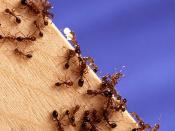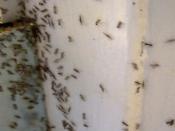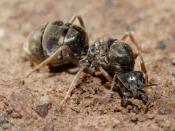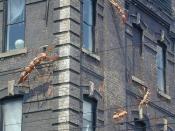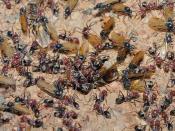IntroductionAs humans, we constantly strive to be on top and yet, we understand that to accomplish amazing tasks, we cannot do it alone. Teamwork is the essence of great success. In animals, we see that cuttlefish are very intelligent creatures but they are missing something. Ants, on the other hand, are mere insects but they have evolved to be so much more. Alone, an ant is nothing except a lowly bug. When put into a group, these ants operate as one unified entity. They are often referred to as a "super organism". These societies are amazing phenomenon that deserves a closer look.
Ants are highly organized arthropods that below to subphylum Uniramia. They are eusocial insects of the family Formicidae and belong to the order Hymenoptera. Ants are very diverse as they have more than 12, 000 species. Ants have colonized almost every landmass on Earth and may constitute up to 25% of the total terrestrial animal biomass.
They are known for their highly organized colonies and nests, which can contain up to millions of individuals. Each ant is given a particular job and it depends on the rest of the colony for its survival just as the community depends on this particular ant. Individuals are divided into three main castes, the sterile females which include workers, soldiers and other odd jobs, fertile males known as drones, and the fertile female a.k.a the queen of the colony.
CommunicationIn any eusocial society, the key to survival and improvement is communication. Ants communicate with each other mainly through the use of chemicals called pheromones. These chemicals are present in most insects but are much more advanced in ants. Ants sense or smell with long and thin antennae located on the top of their head. Because they come in pairs, they provide information about direction as well as intensity. Here are some communication techniques used by ants.
"Alarm" - Ants use a special pheromone for defensive purposes. When attacked, ants are small and do not present much of a threat so an individual ant will always call others. When released in low concentration, it causes the other ants to adapt a state of readiness or warns others of an impending danger. A crushed or severely wounded ant however will emit a high concentration of alarm pheromones that would send nearby ants into an attack frenzy. Some species use a highly evolved "propaganda pheromone", which would confuse enemies and cause them to fight amongst themselves.
"Friend or Foe?" - Pheromones are used to identify certain individuals. You can often see ants approaching each other and "sniffing" with their sensitive antennae. This is done to make sure the other ant is a colony member and not an intruding ant from another area. Friends would go along their business or show courtesy by feeding one another. If they are foe, the ants either run or begin battle.
"Follow me" - When a forager ant is walking around and all of sudden finds a food source, how does it get the rest of her colony to find it? Ants spend their life in contact with the ground, which makes the soil surface a great place to leave a pheromone trail that the other ants can follow. They simply touch the tip of there abdomen on the trail back to the colony which leaves a special marking pheromone As it meets up with nest mates, the excited ant will harass them by knocking against them and touching antennae, which causes other ants to follow the trail back to the food source. After a while, a line of ants can be observed making their way between the nest and food. As other ants come and leave, they reinforce the trail. When food is exhausted, no new trails are marked by returning ants and the scent slowly fades.
"How does it look doctor?" - Pheromones can also be exchanged, mixed with food, and passed. This gives other ants information about one another's health and nutrition. Ants can also use this to detect what task group (forging or nest maintenance) other ants belong to. The queen can emit a pheromone known as "queen substance" that causes infertility in other female ants and gives orders to raise them as workers.
Creation of a ColonyStage 1: The Founding StageDuring the summer, it is a fantastic sight to see when ants take to the air. Large winged female ants and their smaller male mates while gracefully glide in the air, looking for a partner. Following the thermal currents, they find themselves. Ants may mate in the air with the male perched on top of the queen or on the ground but once mated, the queen will fly off leaving the male to curl up and die; his only role in life fulfilled. The female may mate several more times before she starts to seek a suitable nest site. The queen must start the new nest completely on her own. When a good area is found, she discards her wings and digs herself a tunnel leading to small chamber with great urgency. The lonely mother will never see sunlight again.
Stage 2: The Ergonomic StageOnce happy with the make-shift nest, she begins a process of great hardship and endurance. During this time, she will neither eat nor drink and can only live off of the wing muscles in her thorax. She will lay eggs straight away if it's warm which will hatch within 8-15 weeks depending on the species.
The larvae's grow and become adults. They are small and timid compared to the later generation that will follow. They have the most important jobs as the survival of the colony depends on this crucial point in time. The workers must swiftly begin to expand the nest, tend to the queen and broad and eventually remove the seal from the chamber entrance and forage for food. The queen must act as the leader and help regulate the colonies activities but as time goes on, she will cease all other functions and become nothing but an egg laying machine.
Stage 3: The Reproductive StageThe colony will exponentially increase in size and number. The ants produced will become bigger, stronger, and more aggressive. As the society grows, the complexity of job divisions amplifies as new castes are added. After a year or so when the colony is at a certain population, the queen will lay eggs. The ants that emerge will have wings. Once again, they take flight in the mating process in hopes of creating a new colony.
Castes: Division of LaborWorker AntsThese ants make up most the colony and are infertile females. As the caste name suggests, these ants are given the responsibility of carry out the daily tasks. Within this broad section, there are many sub-castes. Different worker ants are given different jobs like foraging, brood care, nest repair, defense and tending to the queen. An important job is nest maintenance as ants understand the significance of hygiene and disease prevention. This includes, cleaning and transporting dead ants out of the nest. In certain cases, workers may lay eggs, but are normally used as food. However, they may develop into male ants which would only be allowed to happen when the queen has died. Although the colony is doomed, at least the male may carry-on the genes and fertilize a virgin ant elsewhere.
SoldiersSome colonies have specialized soldier ants. They are the largest of the castes. They have enlarged jaws that snap shut at great speeds. Huge muscles allow them move around faster and inflict more harm on enemies. Worker ants are usually first at the scene but soldiers follow close behind when more assistance is needed.
Queen AntsQueens must first go through great hardship to start up a colony. During this time, she does not eat or drink. Queens also never see the sun after they have settled. After her first brood has grown into adults, she ceases all other responsibilities and her existence will solely be for the purpose of egg laying. Queens are larger than workers and can be instantly recognizable by the difference in size of the thorax. The abdomen is also engrossed to accommodate the advanced egg producing organs. They also produce a special pheromone known as "queen substance" that causes infertility in worker ants. After the population has reached a certain high, the queen must then produce fertile females and males in hopes that another colony can be created nearby. Queens are the longest living ants in the colony.
Male AntsMale ants have a very minor role in the societies. They are winged and only have one role in life - to inseminate a virgin queen during the mating flight. Once they have performed this task, they will live for only 1 to 2 more days before they curl up and die. Sometimes referred to as "drones", male ants are the smallest and live the shortest amount of time.
Other Cool Stuff"Sneaky Take-Over" Some newly mated queens of the species Formica Sanguinea create colonies in a different way. The new queens will force her way through another colonies nest with stealth and strength and create a sub-cell where she defends and steals a couple of broods. Once the broods hatch, under the control of the intruder, they are able to infiltrate the colony due to their similar appearance. They then kill the original queen which allows the other to take her place on the throne.
"Biological Storage System" In desert-dwelling ants, they have very unique caste. The ants in this group serve as living storage! When food has been collected, it is simply fed to certain ants. Eventually, their stomach expands to a massive size. When ordinary workers get hungry, the balloon ants regurgitate some of the stored food into the workers mouth.
"I Am Your Master" Several ant species, such as those of the Polyergus genus, capture the young of other ants to raise and keep as servants. Some species of "slavemakers" cannot survive without their captives to feed them and care for their young.
"Hillbilly Ants" A species of ants farm! As crazy as that sounds, leaf-cutting ants grow their food in huge underground nests. Workers cut bits of leaves and carry them to the chamber, where they compost leaves and droppings. A special fungus grows on the compost. The ants are so sensitive that they know how the fungus reacts to different plant material. If they find that one leaf is poisonous, they will no longer collect it. All life stages eat only this fungus.
"You Won't Like Me When I am Angry" The bulldog has nothing on the Australian bulldog ant. These critters aggressively chase down prey. It's not surprising that they always catch what they want as they can jump nearly a foot, have monstrous inch long jaws and ü inch-long poisonous stinger.
"Path of Destruction" If you are an insect, you might want to stay away from the African Driver ant. These army ants travel in huge columns for long distances and periods of time, capturing EVERY insect in their way. They destroy and even eat small animals. Driver ants love invading other colonies. They are known to search every tunnel and chamber, devouring the king and queen of termites/ants as well as many thousands of workers. A driver-ant raid can wipe out an entire colony.
"Symbiotic Love" A species of caterpillars are herded by ants! Myrmecohilious caterpillars are moved to ideal feeding areas in the daytime and brought back inside the ant's nest at night for safe keeping. The caterpillars have a gland which secretes honeydew, a sweet sugar high in energy which ants love. Aphids also secret this liquid and will produce it when asked politely through a gentle tap by an ants antennae. The ants in turn will keep predators away and move the aphid around to better feeding locations.
"Feels like Burning" Fire ants use there jaws to lock on to their prey or enemy and use their abdomen to sting. The sensation caused by the venom is compared to being lit on fire. This is where the Fire ant gets its' name.
Grzimek, Bernhard. "Chapter 18 Hymenoptera." Grzimek's Animal Life Encyclopedia: Insect. Volume 2. 1975 edition.
Kinney, Karin. Understanding Science and Nature: Insects and Spiders. US: Time Life Inc, 1992.
Morgan, Randy C. "Leaf-cutting Ants." Sasi Online. Feb 26th 2008. < http://www.sasionline.org/antsfiles/pages/atta/Atta.html >"Ant Colonies." Australian Museum. Feb 24th 2008.
"Castes of Ants." Myrms Ant Nest. Feb 23rd 2008.
< http://www.antnest.co.uk/caste.html>"All About Ants." Info West. Life Studies. Feb 24th 2008
